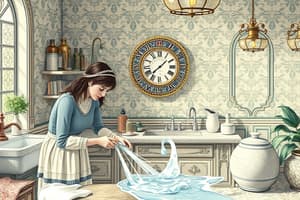Podcast
Questions and Answers
What is the process of cleaning?
What is the process of cleaning?
Cleaning removes dirt, debris, stains, and spills using hot water, detergent, scrubbing/wiping implements, and clean water for rinsing.
What does sanitizing do?
What does sanitizing do?
Sanitizing reduces the number of germs on a clean surface using heat or chemicals.
What is the first step in the cleaning and sanitizing process?
What is the first step in the cleaning and sanitizing process?
- Clean and rinse the surfaces (correct)
- Scrape the surfaces
- Sanitize the surfaces
- Dry the surfaces
The 3-sink process involves only rinsing dishes.
The 3-sink process involves only rinsing dishes.
What is the minimum temperature for the first sink in the 3-sink process?
What is the minimum temperature for the first sink in the 3-sink process?
What temperature should dishes be sanitized at in the 2-sink process?
What temperature should dishes be sanitized at in the 2-sink process?
What should you do before using the dishwasher?
What should you do before using the dishwasher?
How should cutting boards and utensils be cleaned?
How should cutting boards and utensils be cleaned?
What is the correct way to clean electric equipment?
What is the correct way to clean electric equipment?
Test strips should be used to measure the strength of sanitizing solutions.
Test strips should be used to measure the strength of sanitizing solutions.
How should wiping cloths be stored?
How should wiping cloths be stored?
When cleaning up spills, you should tell people to avoid the __________ of the spill.
When cleaning up spills, you should tell people to avoid the __________ of the spill.
Cleaners and non-food items should be stored with food items.
Cleaners and non-food items should be stored with food items.
Flashcards are hidden until you start studying
Study Notes
Cleaning and Sanitizing Processes
- Cleaning involves removing dirt, debris, stains, and spills using hot water, detergent, and rinsing.
- Sanitizing reduces the number of germs on cleaned surfaces using heat or chemicals.
- A three-step process: First, surfaces must be cleaned and rinsed; then sanitized. Follow the steps: pre-scrape, wash, rinse, sanitize, and air dry.
Cleaning Methods
-
The 3-sink process:
- Sink 1: Wash dishes in detergent water (minimum 110°F).
- Sink 2: Rinse cleaned dishes under hot running water.
- Sink 3: Sanitize using chemical solutions (Chlorine: 50-100 ppm; Quaternary ammonium: 100-150 ppm) for at least 30 seconds at 75°F-120°F.
- Air dry items in a strainer; avoid using towels.
-
The 2-sink process:
- Sink 1: Similar to the first sink of the 3-sink process.
- Sink 2: Sanitize using either chemical sanitizer or immersion in water (minimum 171°F).
- Items should be air-dried.
Dishwasher Use
- Load rinsed and scraped dishes properly for thorough cleaning.
- High-temperature dishwashers sanitize using water at 180°F-194°F; excessive heat can bake food onto dishes.
- Low-temperature dishwashers operate at 120°F, using chemicals for sanitization.
- Always allow dishes to air-dry after use.
Equipment Cleaning
- Clean and sanitize cutting boards, knives, and utensils after each use.
- Rinse food processors and slicers with clean water and then sanitize.
Electric Equipment and Utensils
- Always unplug equipment before cleaning.
- Wash surfaces with soapy water, rinse, and use a bleach solution to sanitize.
- Clean removable parts separately and allow them to air-dry before reassembly.
Sanitizing Solutions
- Use test strips to measure sanitizing solution strength; a blue strip indicates 50-100 ppm concentration for bleach.
- Ensure solutions are fresh and at the correct concentration to be effective.
Wiping Cloths
- Use separate cloths for surfaces that come into contact with food and those that do not.
- Store each type of cloth in its own sanitizing solution bucket and always use sanitized cloths for clean-up.
Spill Management
- Warn individuals to avoid spilled areas and clean up using a mop with the correct solution.
- Post warning signs while the area dries and wash hands after dealing with spills.
Chemical Storage
- Always store cleaners and non-food items separately from foods, in designated shelves or cupboards.
Studying That Suits You
Use AI to generate personalized quizzes and flashcards to suit your learning preferences.



